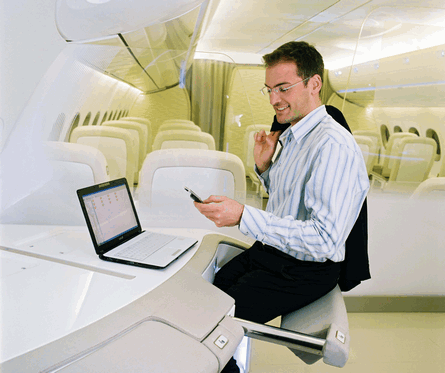Like moths to a flame, airlines are being drawn to in-flight connectivity, setting off an explosion of competition in the Ku-band airborne antenna sector. Some antenna manufacturers have teamed with US partners in a bid to gain prominence and ensure a foothold in that potentially lucrative market. Others are sticking with a go-it-alone campaign. Yet all are now jostling to secure relationships with in-flight connectivity providers that promise to offer passengers the kind of high-bandwidth services already enjoyed on the ground.
The jury is still out as to the pace at which airlines will adopt Ku-band offerings. Gun-shy from the failure of Boeing's Connexion service, many are tempted to first take advantage of Inmarsat's aeronautical service SwiftBroadband, which is supported by L-band geostationary satellites.
 |
|---|
© Airbus |
ADVANTAGES
But Ku-band technology offers three key benefits over rival systems: high-speed connectivity similar to a home internet connection support of services that require significant bandwidth, such as large-scale data transfer and it is considered the only choice for over-water flights.
However, Ku-band remains a "high risk option" until its long-term economic viability can be established, says Benoit Debains, chief executive of the Airbus/Sita joint venture OnAir that is supplying mobile phone and internet connectivity services via SwiftBroadband.
One of the oft-cited reasons for Connexion's demise is the high level of fixed costs that Boeing had to carry in leasing transponders to cover a global footprint. To keep fixed costs down, says William McNary, vice-president of business development for antenna maker AeroSat, service providers are, for example, "applying for only the data they use".
Even so, antenna makers have made it their goal to supply ultra-small, lightweight systems to help make Ku-band-based in-flight connectivity a practical proposition.
A growing list of providers are being targeted: Row 44, a non-exclusive partner to AeroSat that will soon see its system tested by Alaska Airlines and Southwest Airlines in-flight entertainment system manufacturer Panasonic Avionics and ViaSat, which provides satellite communications products and services.
Arinc also offers a Ku-band service for business jets called SkyLink, which provides broadband links to aircraft equipped with Rockwell Collins' eXchange product line. But the company has no firm plans to put SkyLink on the commercial airliner market.
Hoping to capture business with such players and ensure a faster entry into service, Germany's Qest and Israel's Starling have each joined forces with US antenna makers Tecom and EMS Technologies, respectively, to create two power-house teams.
A receive/transmit antenna demonstrator to support bidirectional data services, including voice, will emerge from the Qest/Tecom pairing this year. Qest director of sales and marketing Michael Stobinski says an extended bandwidth model to enable simultaneous direct broadcast satellite-TV as well as data services "will take a few months longer".
In the other camp, Starling may finally reach its goal of trying to break into the US market, following an arrangement that sees EMS Technologies using Starling's Compa (coherent multi-panel) flat-panel technology for its two-way Ku-band family of antenna systems called Aura. Panasonic recently revealed it has selected EMS to supply antennas for its Ku-band connectivity service, eXConnect. These two pairs will compete against AeroSat, which says it does not anticipate partnering another antenna company.
ViaSat, meanwhile, through an agreement with mobile equipment specialist KVH Industries, plans to establish a global Ku-band network for aircraft and ships. Depending upon commercial aircraft type, ViaSat will either develop its own antenna or partner with another antenna manufacturer.
In this regard, ViaSat is in the "constant process of evaluating where to go", says strategy director Bill Sullivan. ViaSat recently selected AeroSat to supply the antenna technology for its broadband communication system for large VIP aircraft.
One thing is for certain, says Sullivan: "There is a lot of pent-up demand for Ku-band and it will happen."
Source: Flight International























